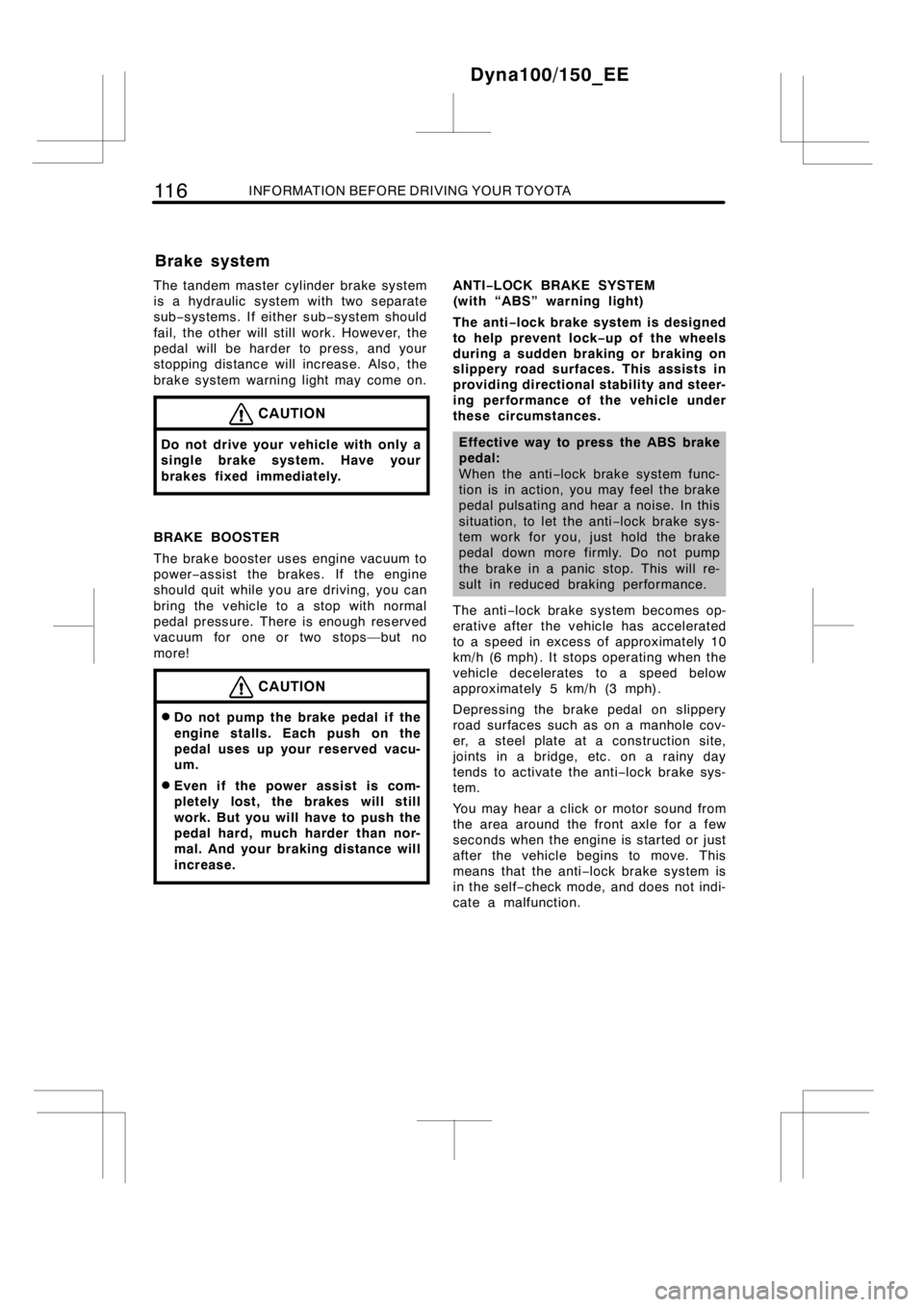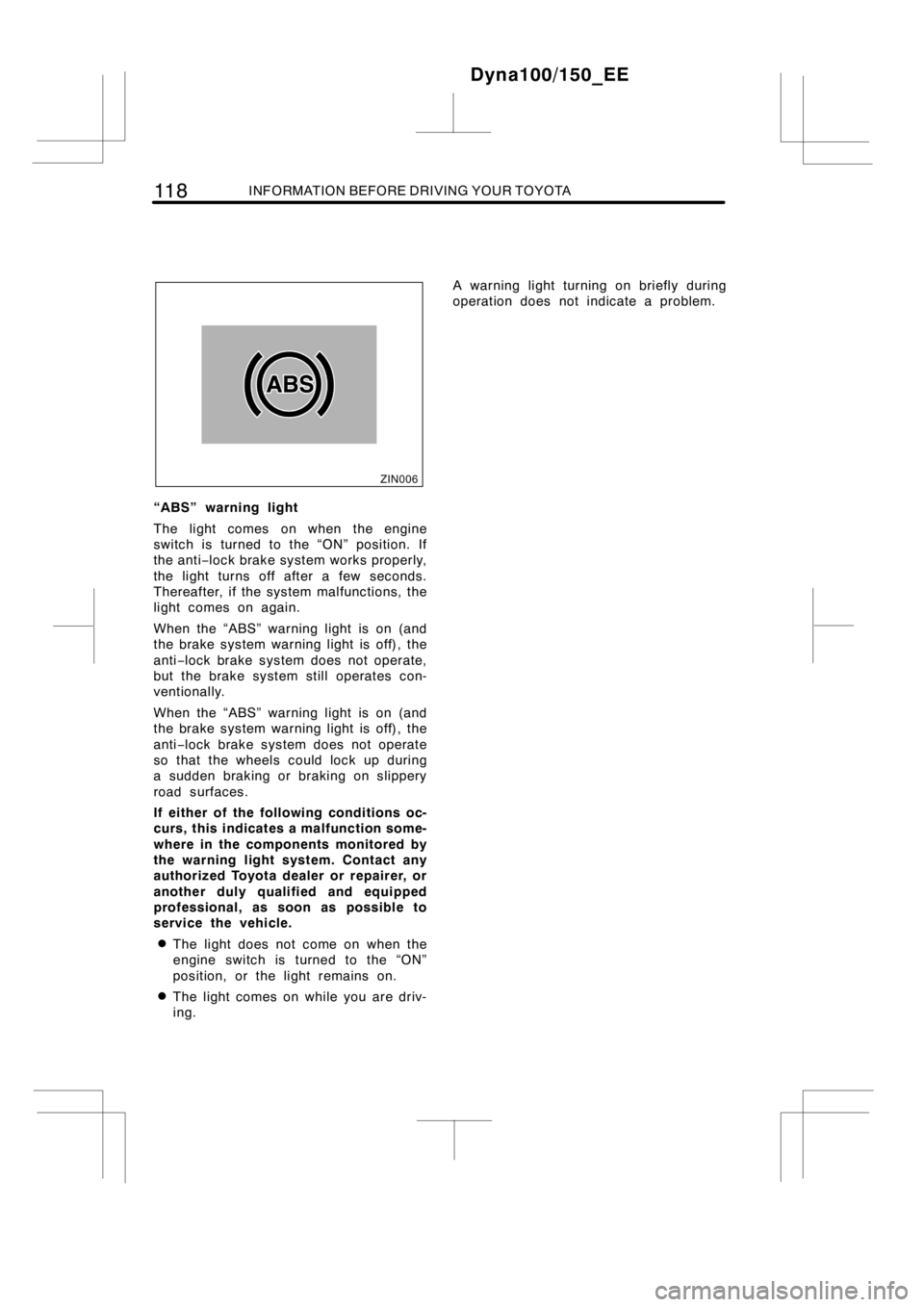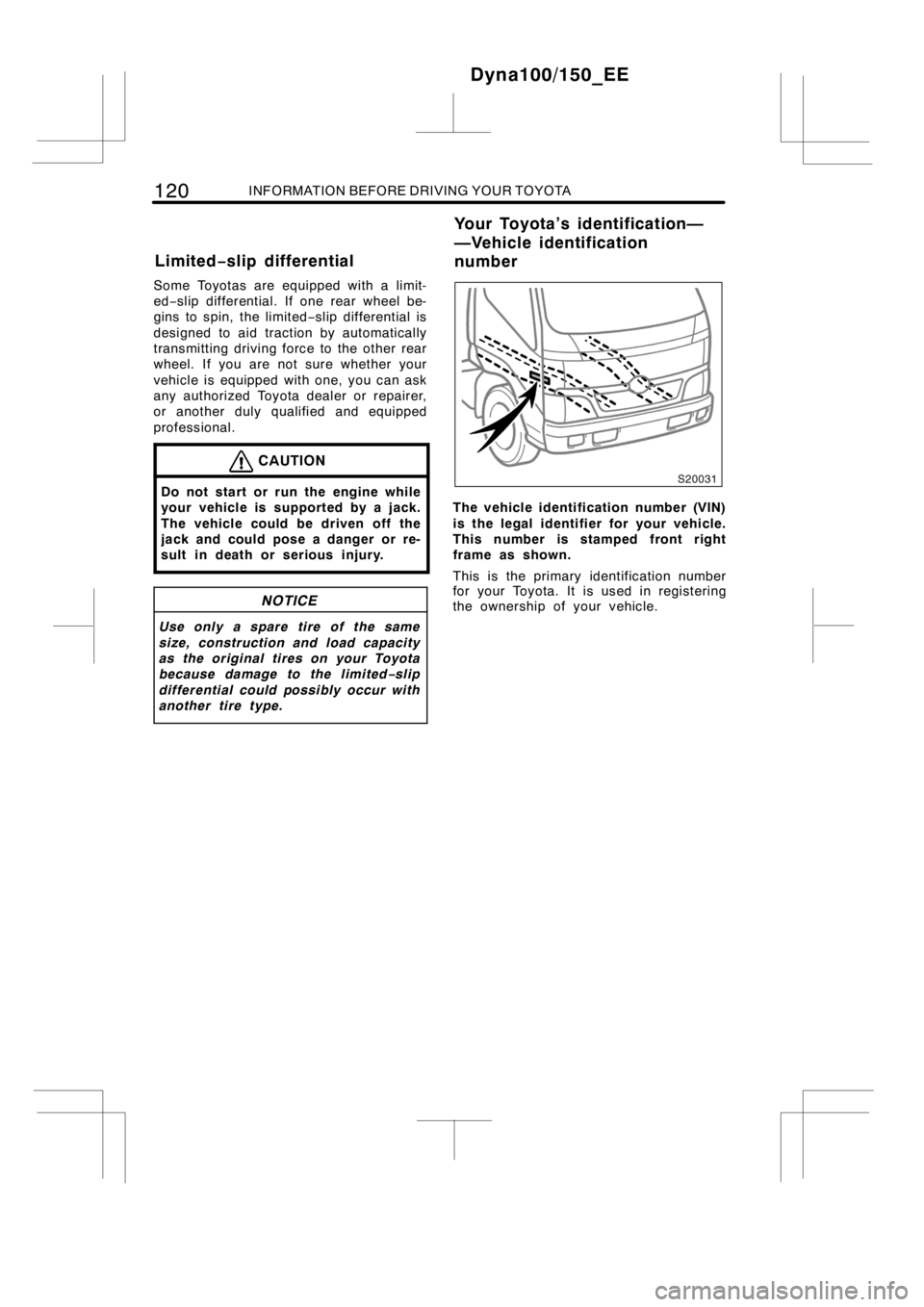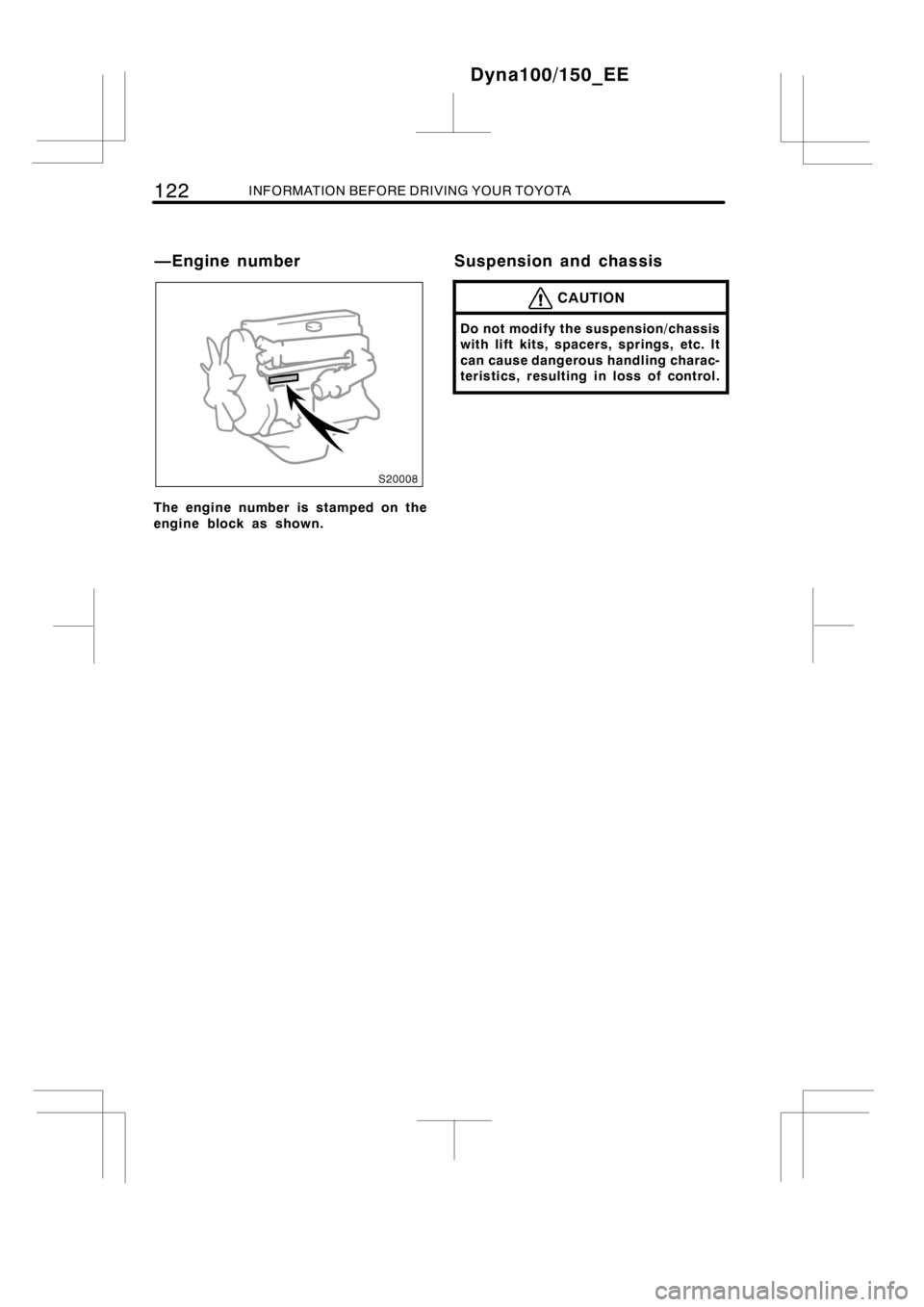2014 TOYOTA DYNA 100/150 engine
[x] Cancel search: enginePage 119 of 232

INFORMATION BEFORE DRIVING YOUR TOYOTA11 3
NOTICE
To prevent damage to the system and
a fire hazard, observe the following
precautions:
zUse only diesel fuel.
zDo not drive for long periods of
time while the DPF system indicator
light is flashing.
zDo not use fuel other than the spe-
cified type.
zDo not use engine oil other than
the recommended type.
zDo not modify the exhaust pipe.
zOperating the vehicle when the en-
gine oil contains a significant
amount of diesel fuel may result in
damage to the engine. If a signifi-
cant amount of fuel is present,
change the oil as soon as possible.
zDo not drive with an extremely low
fuel level; running out of fuel could
cause the engine to misfire, creat-
ing an excessive load on the cata-
lytic converter.
zDo not pull−or push−start your ve-
hicle.
zDo not turn off the engine switch
while the vehicle is moving.
zKeep your engine switch in good
running order. Malfunctions in the
engine electrical system or fuel sys-
tem could cause an extremely high
catalytic converter temperature.
zIf the engine becomes difficult to
start or stalls frequently, take your
vehicle in for a check−up to any
authorized Toyota dealer or repairer,
or another duly qualified and
equipped professional.
zTo ensure that the catalytic convert-
er and the entire emission control
system operate properly, your ve-
hicle must receive the periodic in-
spections required by the Toyota
Maintenance Schedule. For sched-
uled maintenance information, refer
to the “Toyota Service Booklet” or
“Toyota Warranty Booklet”.
Dyna100/150_EE
Page 120 of 232

11 4INFORMATION BEFORE DRIVING YOUR TOYOTA
CAUTION
DExhaust gases include harmful car-
bon monoxide (CO) that is colorless
and odorless. Inhaling exhaust
gases may lead to death or a seri-
ous health hazard.
DThe exhaust should be checked
occasionally. If there is a hole or
crack caused by corrosion, damage
to a joint or abnormal exhaust
noise, be sure to have the vehicle
inspected and repaired by any
authorized Toyota dealer or repairer,
or another duly qualified and
equipped professional. Failure to do
so may allow exhaust gases to
enter the vehicle, resulting in death
or a serious health hazard.
DIf the vehicle is in a poorly venti-
lated area, turn the engine off. In a
closed area, such as a garage, ex-
haust gases may collect and enter
the vehicle. This may lead to death
or a serious health hazard.
DDo not remain for a long time in a
parked vehicle with the engine run-
ning. If it is unavoidable, however,
do so only in an unconfined area
and adjust the heating or cooling
system to force outside air into the
vehicle.
DIf the smell of exhaust is noticed
inside the vehicle, open the win-
dows. Large amounts of exhaust in
the vehicle can cause driver drowsi-
ness and an accident, resulting in
death or a serious health hazard.
Have the vehicle inspected by any
authorized Toyota dealer or repairer,
or another duly qualified and
equipped professional immediately.
DDo not leave the engine running in
an area with snow build−up, or
where it is snowing. If snowbanks
build up around the vehicle while
the engine is running, exhaust
gases may collect and enter the ve-
hicle. This may lead to death or a
serious health hazard.
DWhen taking a nap in the vehicle,
always turn the engine off. Other-
wise, you may accidentally move
the shift lever or depress the accel-
erator pedal, which could cause an
accident or fire due to engine over-
heating. Additionally, if the vehicle
is parked in a poorly ventilated
area, exhaust gases may collect and
enter the vehicle, leading to death
or a serious health hazard.
DToyota does not recommend occu-
pying the rear cargo area when it
is fitted with a slide−in camper,
camper shell or other type cover
while the engine is running. This
caution applies to both driving and
stopped or parked situations with
the engine running. Particular care
should be taken to prevent exhaust
gases from entering camper bodies,
trailers or other enclosures on or
around your vehicle. If exhaust
fumes are detected, open all win-
dows and thoroughly ventilate the
area.
Dyna100/150_EE
Engine exhaust cautions
Page 121 of 232

INFORMATION BEFORE DRIVING YOUR TOYOTA11 5
FUNCTIONS OF ENGINE OIL
Engine oil has the primary functions of
lubricating and cooling the inside of the
engine, and plays a major role in main-
taining the engine in proper working order.
ENGINE OIL CONSUMPTION
It is normal that an engine should con-
sume some engine oil during normal
engine operation. The causes of oil
consumption in a normal engine are as
follows.
DOil is used to lubricate pistons, piston
rings and cylinders. A thin film of oil
is left on the cylinder wall when a pis-
ton moves downwards in the cylinder.
High negative pressure generated when
the vehicle is decelerating sucks some
of this oil into the combustion chamber.
This oil as well as some part of the oil
film left on the cylinder wall is burned
by the high temperature combustion
gases during the combustion process.
DOil is also used to lubricate the stems
of the intake valves. Some of this oil
is sucked into the combustion chamber
together with the intake air and is
burned along with the fuel. High tem-
perature exhaust gases also burn the
oil used to lubricate the exhaust valve
stems.
The amount of engine oil consumed de-
pends on the viscosity of the oil, the
quality of the oil and the conditions the
vehicle is driven under.
More oil is consumed by high−speed driv-
ing and frequent acceleration and decel-
eration.
A new engine consumes more oil, since
its pistons, piston rings and cylinder walls
have not become conditioned.
Oil consumption:Max. 1.0 L per 1000
km (1.1 qt./600 miles, 0.9 Imp. qt./600
miles)When judging the amount of oil con-
sumption, note that the oil may become
diluted and make it difficult to judge
the true level accurately.
As an example, if a vehicle is used for
repeated short trips, and consumes a nor-
mal amount of oil, the dipstick may not
show any drop in the oil level at all, even
after 1000 km (600 miles) or more. This
is because the oil is gradually becoming
diluted with fuel or moisture, making it
appear that the oil level has not changed.
The diluting ingredients evaporate out
when the vehicle is then driven at high
speeds, as on an expressway, making it
appear that oil is excessively consumed
after driving at high speeds.
IMPORTANCE OF ENGINE OIL LEVEL
CHECK
One of the most important points in prop-
er vehicle maintenance is to keep the en-
gine oil at the optimum level so that oil
function will not be impaired. Therefore, it
is essential that the oil level be checked
regularly. Toyota recommends that the oil
level be checked every time you refuel
the vehicle.
NOTICE
Failure to check the oil level regularly
could lead to serious engine trouble
due to insufficient oil.
For detailed information on oil level check,
see “Checking the engine oil level” on
page 188 in Section 7−2.
Dyna100/150_EE
Facts about engine oil
consumption
Page 122 of 232

11 6INFORMATION BEFORE DRIVING YOUR TOYOTA
The tandem master cylinder brakesystem
is a hydraulic system with two separate
sub−systems. If either sub−system should
fail, the other will still work. However, the
pedal will be harder to press, and your
stopping distance will increase. Also, the
brake system warning light may come on.
CAUTION
Do not drive your vehicle with only a
single brake system. Have your
brakes fixed immediately.
BRAKE BOOSTER
The brake booster uses engine vacuum to
power−assist the brakes. If the engine
should quit while you are driving, you can
bringthevehicletoastopwithnormal
pedal pressure. There is enough reserved
vacuum for one or two stops—but no
more!
CAUTION
DDo not pump the brake pedal if the
engine stalls. Each push on the
pedal uses up your reserved vacu-
um.
DEven if the power assist is com-
pletely lost, the brakes will still
work. But you will have to push the
pedal hard, much harder than nor-
mal. And your braking distance will
increase.
ANTI−LOCK BRAKE SYSTEM
(with “ABS” warning light)
The anti−lock brake system is designed
to help prevent lock−up of the wheels
during a sudden braking or braking on
slippery road surfaces. This assists in
providing directional stability and steer-
ing performance of the vehicle under
these circumstances.
Effective way to press the ABS brake
pedal:
When the anti−lock brake system func-
tion is in action, you may feel the brake
pedal pulsating and hear a noise. In this
situation, to let the anti−lock brake sys-
tem work for you, just hold the brake
pedal down more firmly. Do not pump
the brake in a panic stop. This will re-
sult in reduced braking performance.
The anti−lock brake system becomes op-
erative after the vehicle has accelerated
to a speed in excess of approximately 10
km/h (6 mph). It stops operating when the
vehicle decelerates to a speed below
approximately 5 km/h (3 mph).
Depressing the brake pedal on slippery
road surfaces such as on a manhole cov-
er, a steel plate at a construction site,
joints in a bridge, etc. on a rainy day
tends to activate the anti−lock brake sys-
tem.
You may hear a click or motor sound from
the area around the front axle for a few
seconds when the engine is started or just
after the vehicle begins to move. This
means that the anti−lock brake system is
in the self−check mode, and does not indi-
cate a malfunction.
Dyna100/150_EE
Brake system
Page 124 of 232

11 8INFORMATION BEFORE DRIVING YOUR TOYOTA
“ABS” warning light
The light comes on when the engine
switch is turned to the “ON” position. If
the anti−lock brake system works properly,
the light turns off after a few seconds.
Thereafter, if the system malfunctions, the
light comes on again.
When the “ABS” warning light is on (and
the brake system warning light is off), the
anti−lock brake systemdoes not operate,
but the brake system stilloperates con-
ventionally.
When the “ABS” warning light is on (and
the brake system warning light is off), the
anti−lock brake systemdoes not operate
so that the wheels could lock up during
a sudden braking or braking on slippery
road surfaces.
If either of the following conditions oc-
curs, this indicates a malfunction some-
where in the components monitored by
the warning light system. Contact any
authorized Toyota dealer or repairer, or
another duly qualified and equipped
professional, as soon as possible to
service the vehicle.
DThe light does not come on when the
engine switch is turned to the “ON”
position, or the light remains on.
DThe light comes on while you are driv-
ing.A warning light turning on briefly during
operation does not indicate a problem.
Dyna100/150_EE
Page 126 of 232

120INFORMATION BEFORE DRIVING YOUR TOYOTA
Some Toyotas are equipped with a limit-
ed−slip differential. If one rear wheel be-
gins to spin, the limited−slip differential is
designed to aid traction by automatically
transmitting driving force to the other rear
wheel. If you are not sure whether your
vehicle is equipped with one, you can ask
any authorized Toyota dealer or repairer,
or another duly qualified and equipped
professional.
CAUTION
Do not start or run the engine while
your vehicle is supported by a jack.
The vehicle could be driven off the
jack and could pose a danger or re-
sult in death or serious injury.
NOTICE
Use only a spare tire of the same
size, construction and load capacity
as the original tires on your Toyota
because damage to the limited−slip
differential could possibly occur with
another tire type.
The vehicle identification number (VIN)
is the legal identifier for your vehicle.
This number is stamped front right
frameasshown.
This is the primary identification number
for your Toyota. It is used in registering
the ownership of your vehicle.
Dyna100/150_EE
Limited−slip differentialYour Toyota’s identification—
—Vehicle identification
number
Page 128 of 232

122INFORMATION BEFORE DRIVING YOUR TOYOTA
The engine number is stamped on the
engine block as shown.
CAUTION
Do not modify the suspension/chassis
with lift kits, spacers, springs, etc. It
can cause dangerous handling charac-
teristics, resulting in loss of control.
Dyna100/150_EE
—Engine number Suspension and chassis
Page 129 of 232

STARTING AND DRIVING123
Section 3
STARTING AND DRIVING
DBefore starting the engine 124..........................
DHow to start the engine 124.............................
DPrecautions for turning off an engine
with turbocharger 126..................................
DPre−trip safety check 126..............................
DTips for driving in various conditions 127.................
DDriving in the rain 128..................................
DWinter driving tips 129.................................
DTrailer towing 130......................................
DHow to save fuel and make your vehicle last longer 138...
Dyna100/150_EE